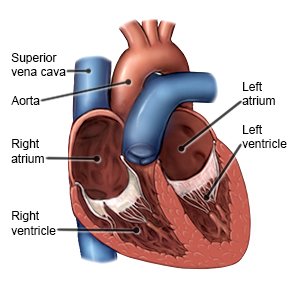Left Atrial Appendage Closure Procedure
Medically reviewed by Drugs.com. Last updated on Aug 4, 2025.
What do I need to know about left atrial appendage closure (LAAC)?
LAAC is a procedure to block or close the left atrial appendage. The appendage is a small pouch in the heart muscle that is connected to your left atrium. Blood clots may form in the appendage if you have atrial fibrillation. This increases your risk for stroke. LAAC helps prevent blood clots from entering your bloodstream and lowers your risk for stroke.
 |
How do I prepare for LAAC?
- Your healthcare provider will tell you how to prepare. You may be told not to eat or drink anything after midnight on the day of your procedure. Arrange to have someone drive you home when you are discharged.
- Tell your provider about all medicines you currently take. Your provider will tell you if you need to start or stop any medicine for the procedure, and when to do so. You may need to take a blood thinner before your procedure. Your provider will tell you which medicines to take or not take on the day of the procedure.
- Tell your provider about any allergies you have, including to anesthesia or medicines. You may be given an antibiotic to help prevent a bacterial infection.
- Your provider will tell you if you need any tests before your procedure, and when to have them. You may need an echocardiogram, CT, or MRI. These tests help show the structure of your heart so your provider can plan your procedure.
Related medications
What will happen during LAAC?
- You will be given general anesthesia to keep you asleep and free from pain during the procedure. Your provider will insert a catheter into a vein near your groin or under your sternum (breastbone). The catheter will be guided to your heart using fluoroscopy (continuous x-rays).
- A hole will be made in the wall that separates your right and left atria. The catheter will go through the hole so it can reach the left appendage. Your provider will insert a device into the opening of the appendage. The device may have netting or mesh to block blood clots. Your provider may instead use a suture or other device to close, plug, or clamp the opening.
- Imaging tests will be done to make sure the device completely blocks the opening. Your provider will make sure the device is secure and stays in place. Your provider will then remove the catheter. The catheter site will be closed and covered with a bandage.
What should I expect after LAAC?
You may need to stay in the hospital overnight or longer. You may need to take blood thinners and aspirin. Your healthcare provider will tell you how long you will need these medicines.
What are the risks of LAAC?
You may bleed more than expected or develop an infection. You may develop a blood clot near the device. Your device may move out of place. You may need another procedure or surgery to fix this. The hole between the atria in your heart may not close. You may have a stroke during the procedure. The outer wall of your heart could be punctured. You will need immediate surgery to fix this. You may have a buildup of fluid around your heart that prevents it from pumping correctly. This can be life-threatening.
Care Agreement
You have the right to help plan your care. Learn about your health condition and how it may be treated. Discuss treatment options with your healthcare providers to decide what care you want to receive. You always have the right to refuse treatment. The above information is an educational aid only. It is not intended as medical advice for individual conditions or treatments. Talk to your doctor, nurse or pharmacist before following any medical regimen to see if it is safe and effective for you.© Copyright Merative 2025 Information is for End User's use only and may not be sold, redistributed or otherwise used for commercial purposes.
Further information
Always consult your healthcare provider to ensure the information displayed on this page applies to your personal circumstances.
